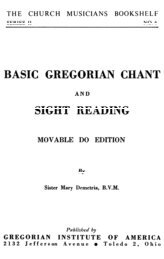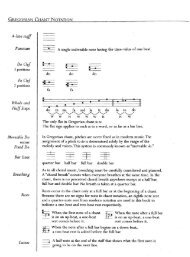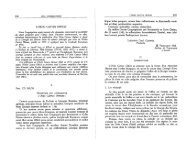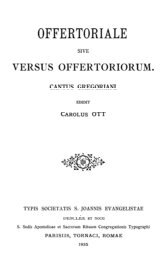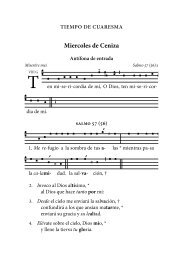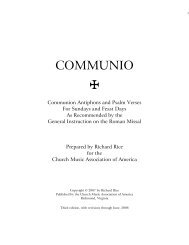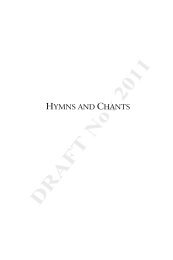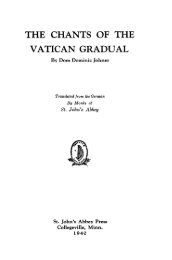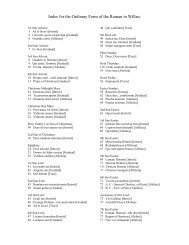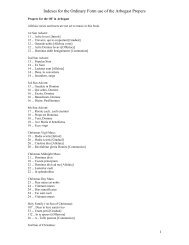Textbook of Gregorian Chant (1930) - MusicaSacra
Textbook of Gregorian Chant (1930) - MusicaSacra
Textbook of Gregorian Chant (1930) - MusicaSacra
You also want an ePaper? Increase the reach of your titles
YUMPU automatically turns print PDFs into web optimized ePapers that Google loves.
Introduction. xiij.<br />
could never say that the words had been " set to music "; the music<br />
springs up out <strong>of</strong> the words themselves in which it lay latent and<br />
contained in embryo. Dom Mocquereau's definition melodieuse<br />
langue x describes the chant far better than music : indeed if one<br />
did not fear to be accused <strong>of</strong> poetical exaggeration, one might well<br />
apply to it the poet's line :<br />
" Speech half asleep or song half awake ". 2<br />
When music breaks away and takes her revenge in the jubilus<br />
and other neumatic passages which sing but do not speak, this is<br />
someting quite exceptional and temporary. The modern pr<strong>of</strong>essional<br />
singer regards words as a more hindrance to music, a<br />
groundwork or scaffolding to be covered up, left behind or escaped<br />
from as quickly as possible. But the <strong>Gregorian</strong> singer must treat<br />
words as holy things, and for this it is essential to appreciate the<br />
grave beauty <strong>of</strong> the Church's Latin. 3 It is more important — and<br />
more difficult, owing to our common neglect <strong>of</strong> careful diction —<br />
for English-speaking students to acquire a good style <strong>of</strong> recitative<br />
than it is for them to master the ornate pieces in the Gradual<br />
or the Antiphonary. To read the text aloud, with correct<br />
accent, clear enunciation and well-balanced phrasing — realising<br />
that the laws <strong>of</strong> free rhythm are largely the laws <strong>of</strong> cultivated<br />
speech, 4 the " rhythm <strong>of</strong> prose " — this is the best preparation for<br />
singing the chant.<br />
When text and melody have been sufficiently studied there<br />
remains the crucial question <strong>of</strong> whether and how much the chant<br />
admits <strong>of</strong> "expression". Is it to be frigidly hieratic, one stiff,<br />
severe line <strong>of</strong> notes, or are the fine shades to be exaggerated until<br />
something emotional and theatrical results? The first extreme<br />
would be preferable to the second, but a happy mean is to be<br />
sought for in this as in most things. Personal taste must first <strong>of</strong><br />
all be set aside. The voice, our voice, is such an intensely intimate<br />
part <strong>of</strong> us that this is bound to involve some sacrifice. Those who<br />
consent to go to school with the Church and study her interpretation<br />
will learn not only what to say to God, but in what tone<br />
and accent. Besides giving them the text and the melody, she<br />
trains her obedient children to the exact kind and degree <strong>of</strong> feeling<br />
to be put into the rendering. The best manuscripts <strong>of</strong> the best<br />
period abound in rhythmical signs, showing how the neums are to<br />
be produced. But it must be understood from the first that when<br />
Holy Church " teaches, prays, meditates, mourns and jubilates in<br />
1 Nombre musicalgrigorien^ Vol. I, Introduction, p. 6.<br />
a ROBERT BROWNING, Flower Fancies.<br />
3 DOM SHEBBEARE, op. tit. — « Justine WARD, op. tit.




